Monday Nov. 27, 2006
In order to save some time after a busy Thanksgiving break, the
lightning notes from the Section 3 class have been moved over to the
Section 2 web page.
We will
spend the whole period on lightning today.
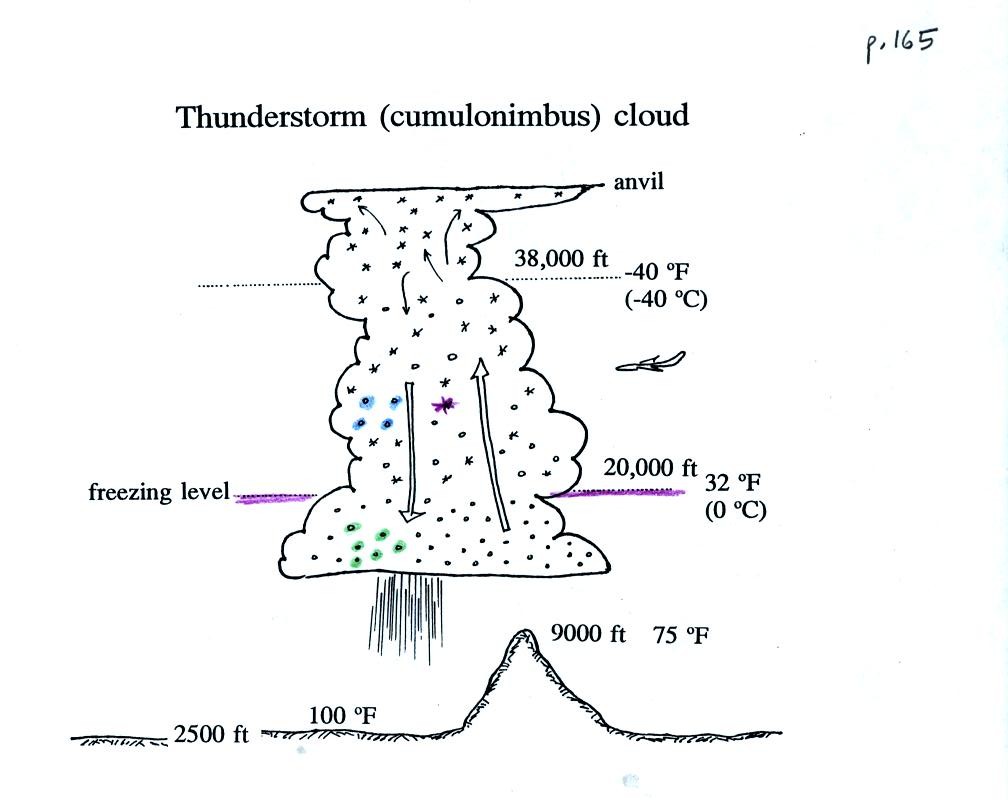
A summer thunderstorm in Tucson. Remember that even in the summer
a large part of the middle of the middle of the cloud is found at below
freezing temperatures and contains a mixture of super cooled water
droplets and ice crystals. This is where the ice crystal process
of precipitation formation operatures and is also where electrical
charge is created.

Collisions between precipitation particles produces the charge needed
for lightning.
When temperatures are below -15 C, graupel becomes negatively charged
after colliding with a snow crystal. The snow crystal is
positively charged and is carried up toward the top of the cloud by the
updraft winds. At temperature warmer than -15 (but still below
freezing), the charging is reversed. Large positive and negative
charge centers begin to build up inside the cloud. When the
electrical attrative forces between these charge centers gets
high enough lightning occurs.
Most
lightning (2/3) stays inside the cloud and travels between the main
positive
charge center near the top of the cloud and a large layer of negative
charge in the middle of the cloud; this is intracloud lightning.
About 1/3 of all lightning
flashes strike the ground. These are called cloud-to-ground
discharges.

Most cloud to ground discharges begin with a negatively charged
downward moving stepped leader. It makes its way down toward the
cloud in 50 m jumps that occur every 50 millionths of a second or
so. Every jump produces a short flash of light. Another
view of the stepped leader is shown below.

Imagine dropping a strobe light from the cloud and watching
it as
it fell from the cloud toward the ground. You'd periodically see
a flash of light as the strobe flashed on and off.
The picture above shows you what you would see on a photograph made on
moving film. Every time the channel jumps and produces a flash of
light the channel is photographed on a slighly different position on
the film. With a telephoto lens you'd see the short 50 m channel
segments that are illluminated during the jump.
As the stepped leader nears the ground, the electrical attraction
between negative charge in the tip of the stepped leader and positive
charge in the ground causes several positively charged upward discharge
to develop. One of these will intercept and connect with the
stepped leader.

Several
positively charged sparks begin to travel upward from the ground. One
of these will eventually intercept the stepped leader.
This
is what determines what will be struck by the lightning.
Lightning doesn't really know what it will strike until it gets close
to the ground. Lightning rods take advantage of this principle.
Houses with and without lightning rods are shown
below. When lightning strikes the house without a lightning rod
the powerful return stroke travels into the house destroying the TV and
possibly starting the house on fire.
A lightning rod is supposed to intercept the stepped leader and safely
carry the lightning current around the house.
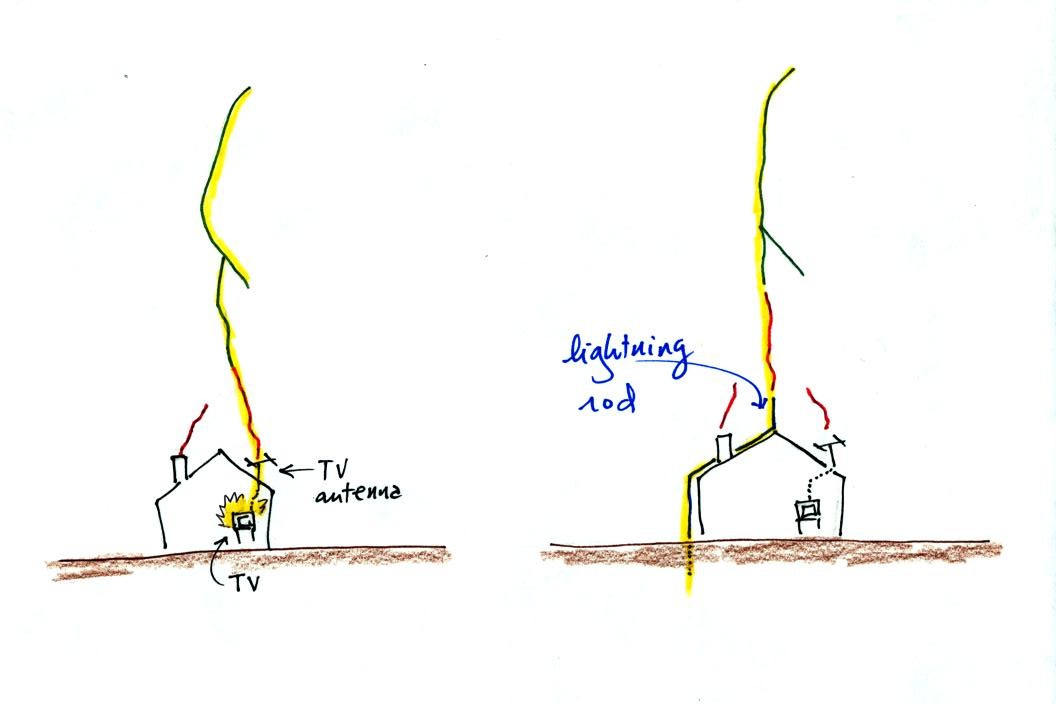
 The
connection between the stepped leader and the upward discharge creates
a "short circuit" between the charge in the cloud and the charge in the
ground. A powerful current travels back up the channel from the
ground toward the cloud. This is the return stroke. Large
currents (typically 30,000 amps in the first return stroke) heat the
air to around 30,000K (5 times hotter than the
surface of the sun) which causes the air to explode. When you
hear thunder, you are hearing the sound produced by this explosion.
The
connection between the stepped leader and the upward discharge creates
a "short circuit" between the charge in the cloud and the charge in the
ground. A powerful current travels back up the channel from the
ground toward the cloud. This is the return stroke. Large
currents (typically 30,000 amps in the first return stroke) heat the
air to around 30,000K (5 times hotter than the
surface of the sun) which causes the air to explode. When you
hear thunder, you are hearing the sound produced by this explosion.
Stepped leader - upward connecting discharge - return stroke
animation
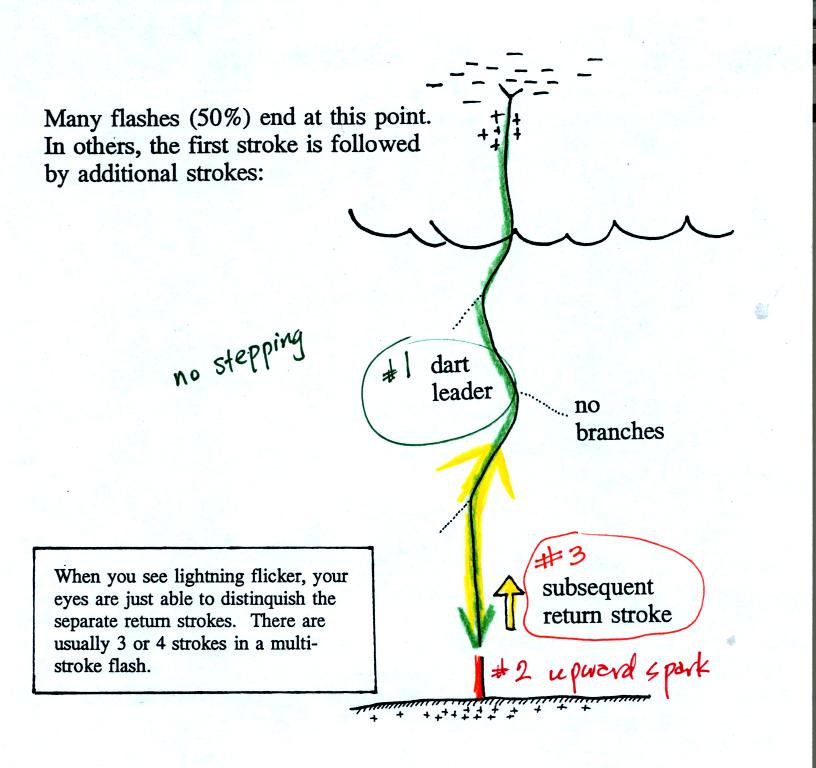
In about 50% of cloud to ground discharges, the stepped leader-upward
discharge-return stroke sequence repeats itself with a few subtle
differences. A downward dart leader travels from the cloud to the
ground. The dart leader doesn't step but travels smoothly and follows
the channel created by the stepped leader (avoiding the
branches). It is followed by a slightly less powerful subsequent
return stroke that travels back up the channel to the cloud.

A normal still photograph would capture the separate return strokes
superimposed on each other. If you bumped or moved the camera
during the photograph the separate return strokes would be spread out
on the image.
The image above shows a multiple stroke flash consisting of 4 separate
return strokes.
There is enough time between separate return strokes (around 1/10 th
second) that your eye can
separate the individual flashes of light.
When lightning appears
to flicker you are seeing the separate return strokes in a multiple
stroke flash. The whole flash usually lasts 0.5 to 1 second.

Occasionally a lightning stroke will travel from the
positive charge
region in the top of the thunderstorm cloud to ground. These
types of strikes are more common at the ends of storms and in winter
storms. This is probably because the top part of the cloud gets
pushed sideways away from the middle and bottom portions of the
cloud. Positive strokes are very powerful. They sometimes
produce an unusually loud and long lasting clap of thunder.
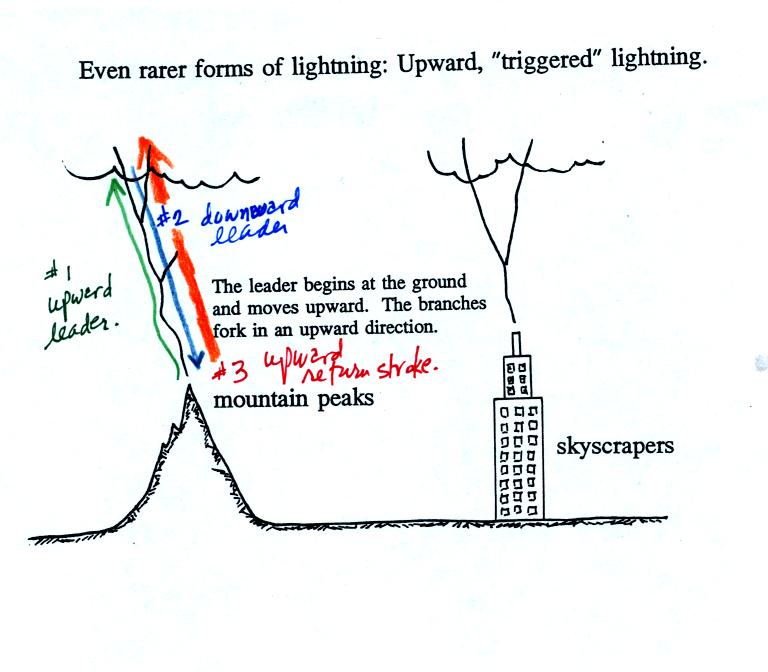
Lightning sometimes starts at the ground and travels
upward.
Upward lightning is generally only initiated by mountains and tall
objects such as a skyscraper or a tower of some kind. These
discharges are initiated by an upward leader. This is followed by
a more normal downward leader and an upward return stroke.

Scientists are able to trigger lightning by firing a small
rocket up
toward a thunderstorm. The rocket is connected by a thin wire to
the ground. When the rocket gets 50 to 100 m above the ground
upward lightning will develop off of the top of the wire.
Scientists are able to take closeup photographs and make measurements
of lightning currents using triggered lightning. Triggered
lightning can also be used to test the operation of lightning
protection devices. A short video showing rocket triggered
lightning experiments was shown in class.
Near the end of the tape you will some cases where the
lightning didn't
follow the wire all the way to the ground (this is one reason why you
need to be very careful doing experiments of this type). When the
lightning strikes the sandy soil (instead of striking instruments on
the ground) it sometimes will leave behind a fulgurite (note spelling
in the figure below is incorrect)
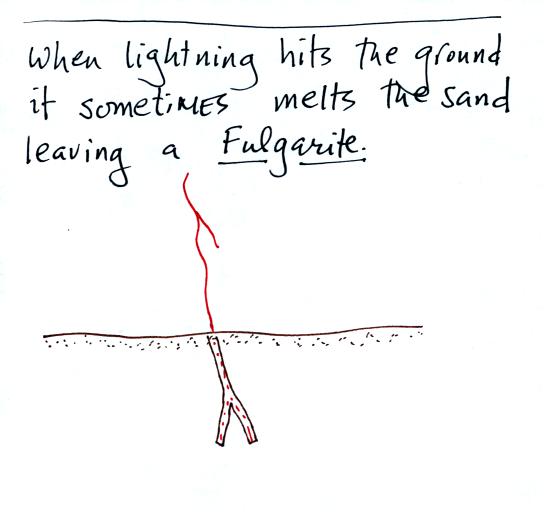

This is a drawing of a science fair project. If 10 to 20
Amps will cook a hotdog,
imagine what the 10,000 to 30,000 Amps in a lightning return stroke can
do. We wrapped up class with some lightning safety information.

Stay away from tall isolated objects during a lightning
storm.
You can be hurt or killed just by being close to a lightning strike
even if you're
not struck directly.
An automobile with a metal roof and body provides good
protection from
lightning. The lightning current will travel through the metal
and around the passengers inside (the people in Florida that were
triggering lightning were inside a metal trailer and were perfectly
safe).
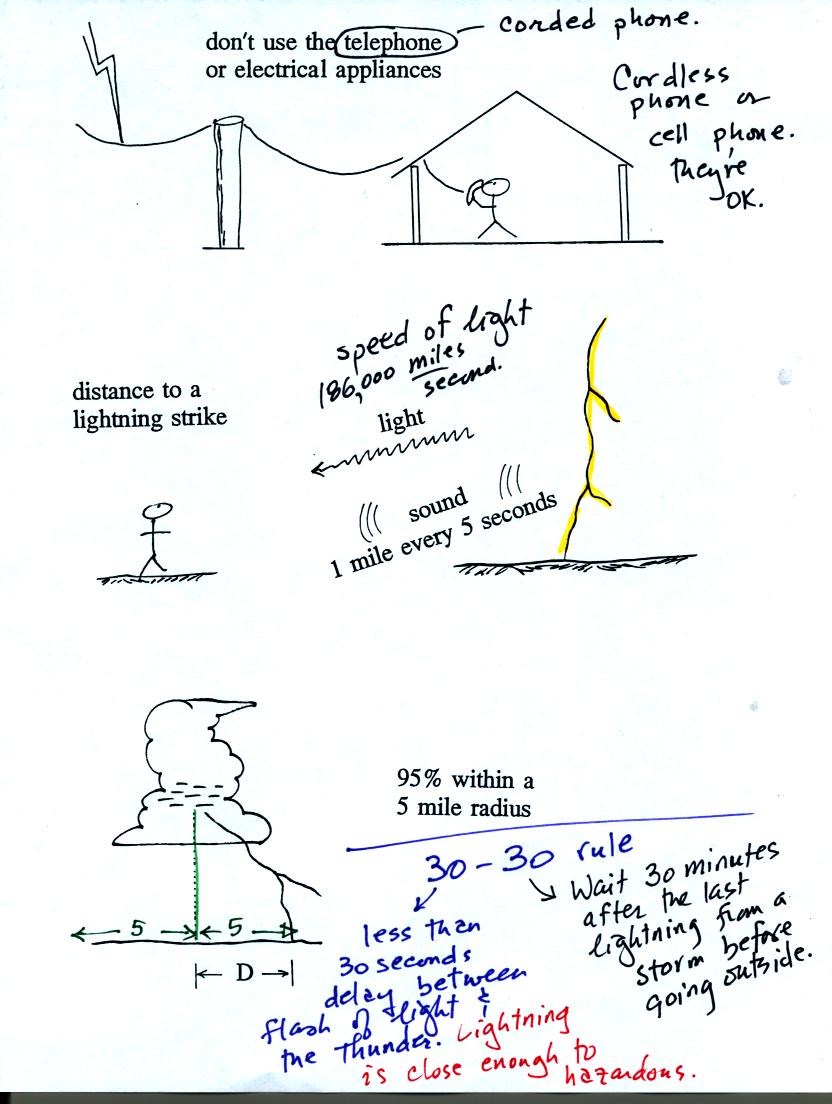
You shouldn't use a corded phone and electrical appliances
during a lightning storm because lightning currents can follow wires
into your home.
To estimate the distance to a lightning strike
count the
number of
seconds between the flash of light and when you first hear the
thunder. Divide this by 5 to get the distance in miles.
If
there is less than 30 seconds delay between the light and the thunder
then the lightning is close enough to present a risk to you. You
should wait 30 minutes after the last lightning before assuming that a
storm has dissipated or moved out of your area.






 The
connection between the stepped leader and the upward discharge creates
a "short circuit" between the charge in the cloud and the charge in the
ground. A powerful current travels back up the channel from the
ground toward the cloud. This is the return stroke. Large
currents (typically 30,000 amps in the first return stroke) heat the
air to around 30,000K (5 times hotter than the
surface of the sun) which causes the air to explode. When you
hear thunder, you are hearing the sound produced by this explosion.
The
connection between the stepped leader and the upward discharge creates
a "short circuit" between the charge in the cloud and the charge in the
ground. A powerful current travels back up the channel from the
ground toward the cloud. This is the return stroke. Large
currents (typically 30,000 amps in the first return stroke) heat the
air to around 30,000K (5 times hotter than the
surface of the sun) which causes the air to explode. When you
hear thunder, you are hearing the sound produced by this explosion.







